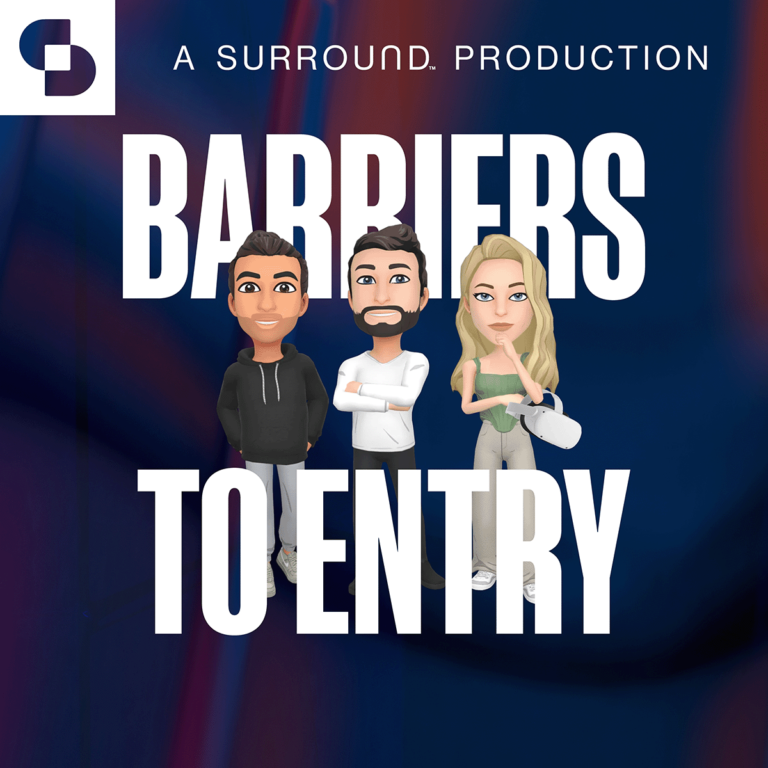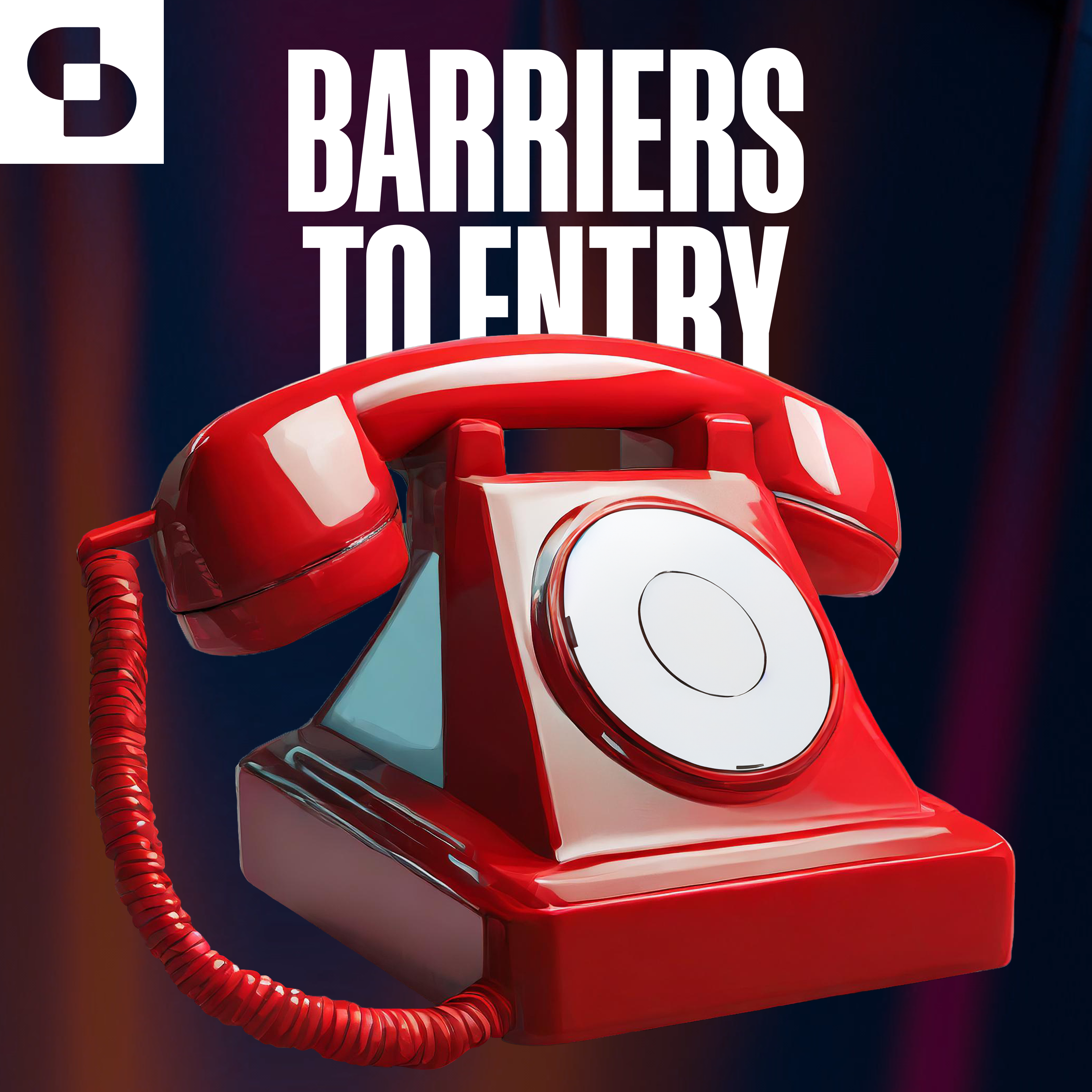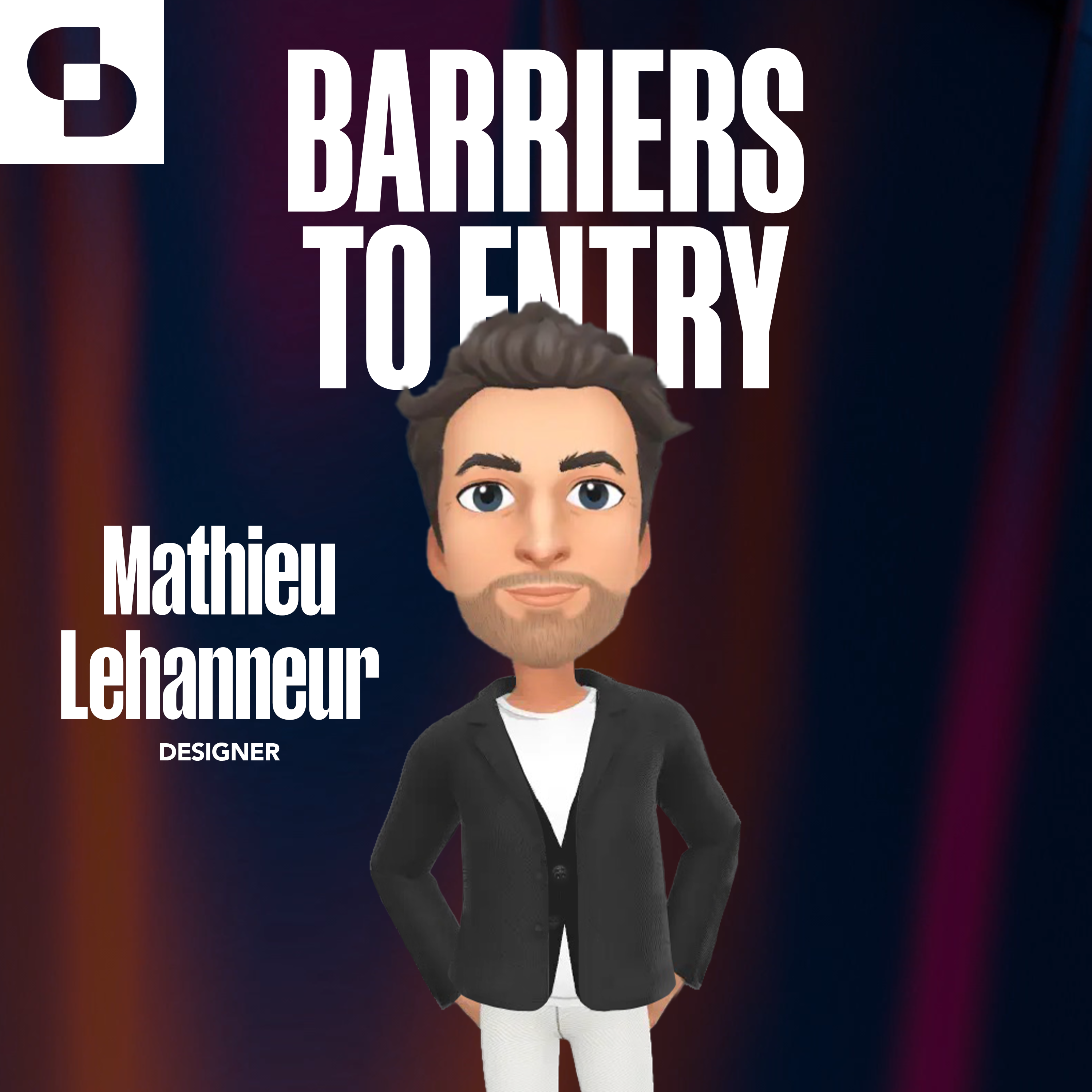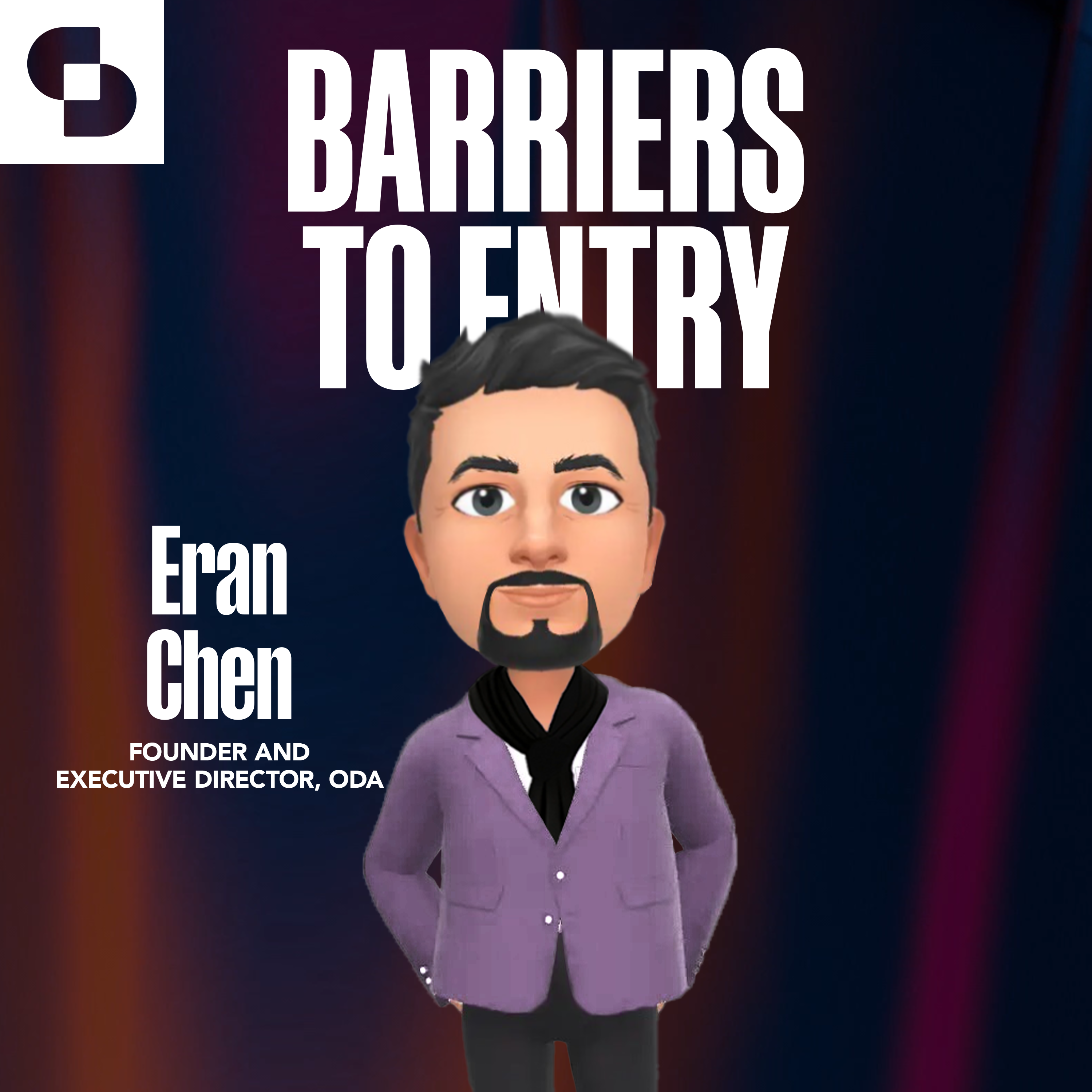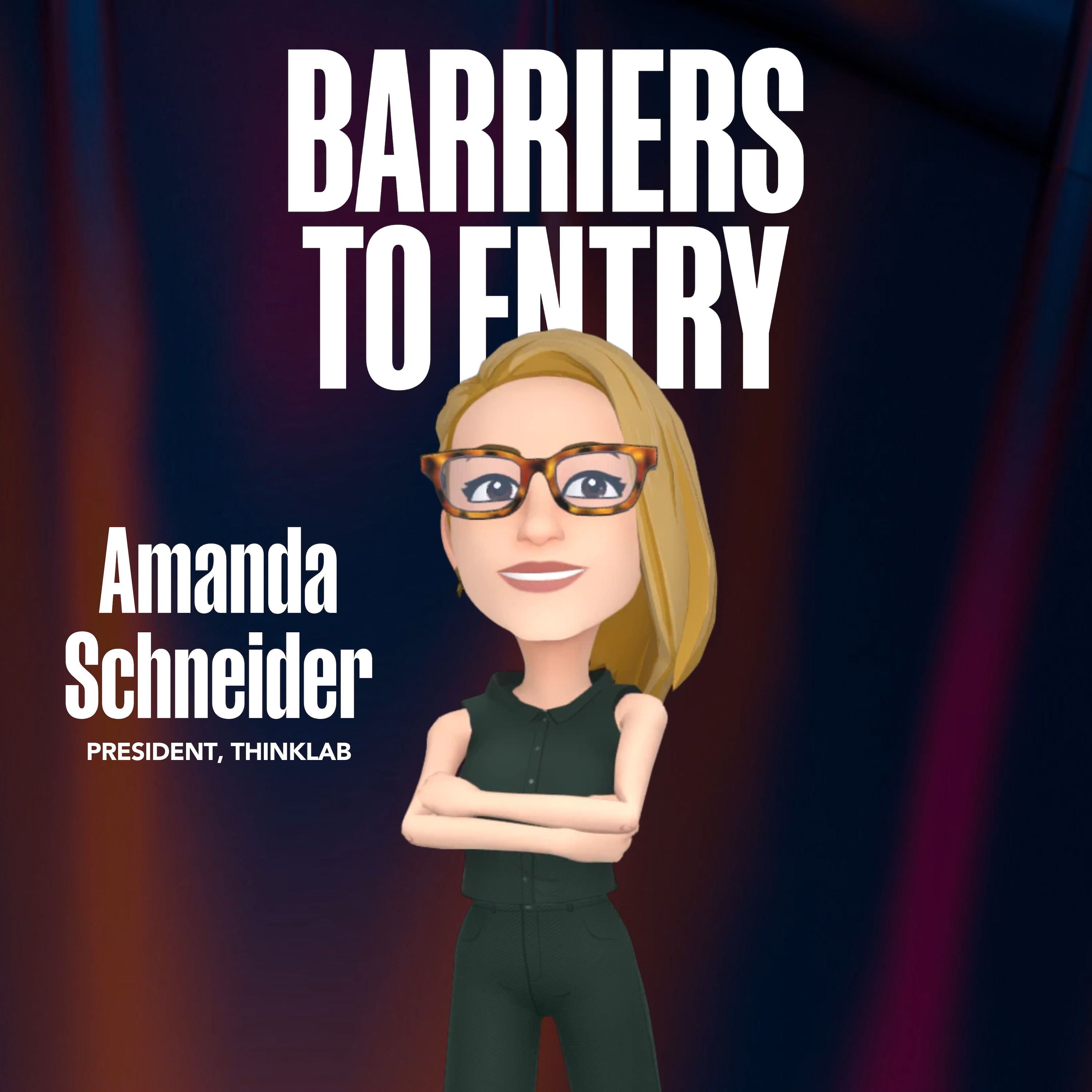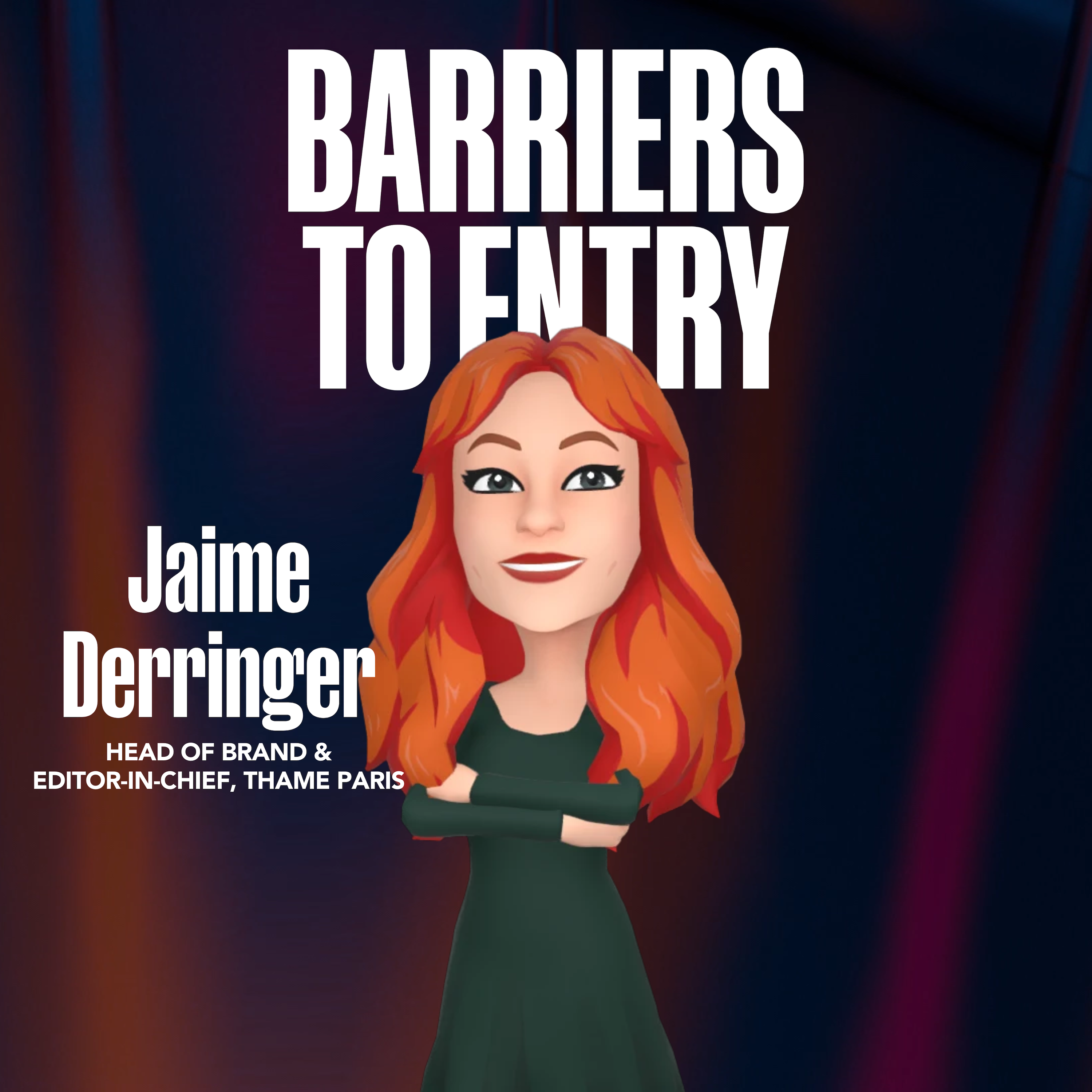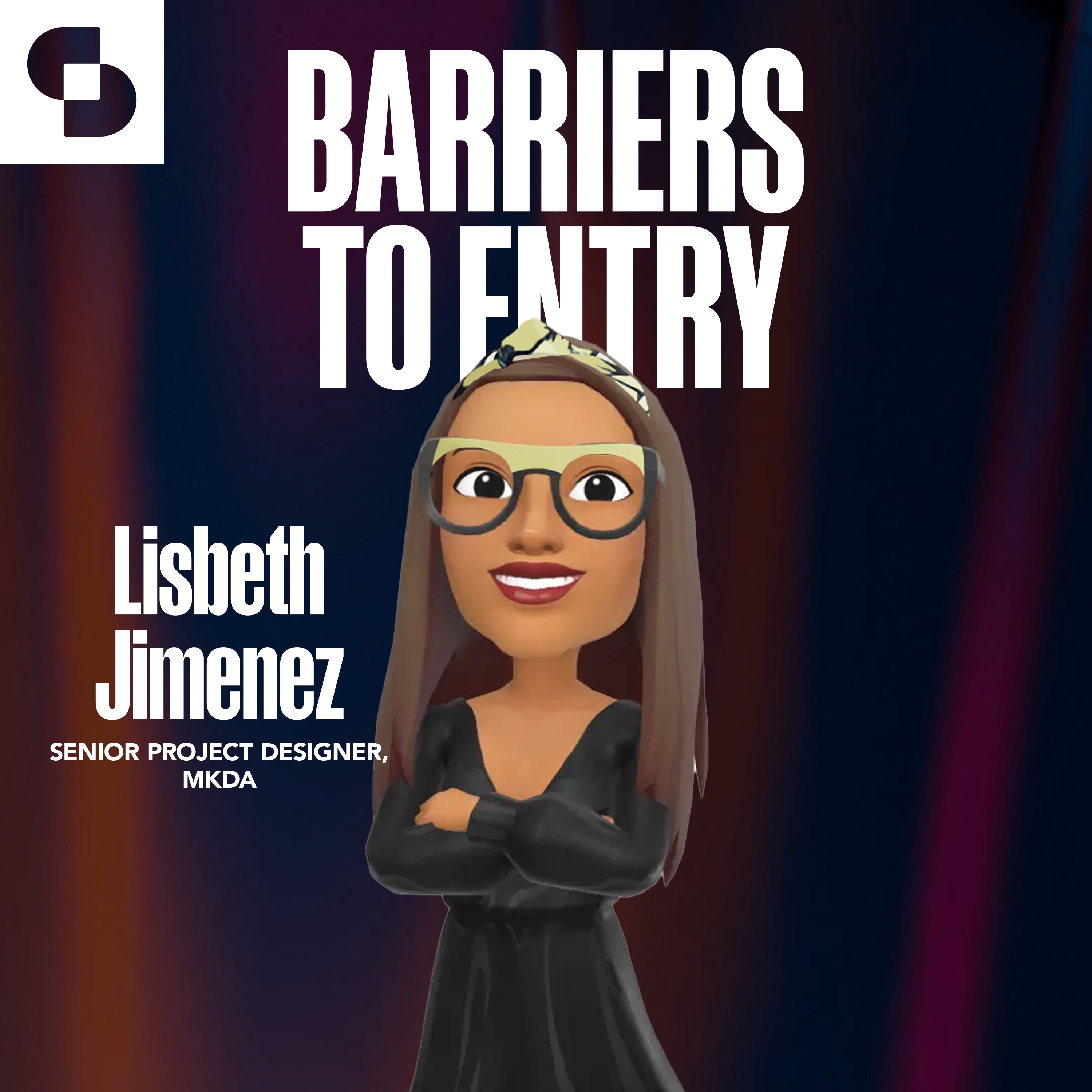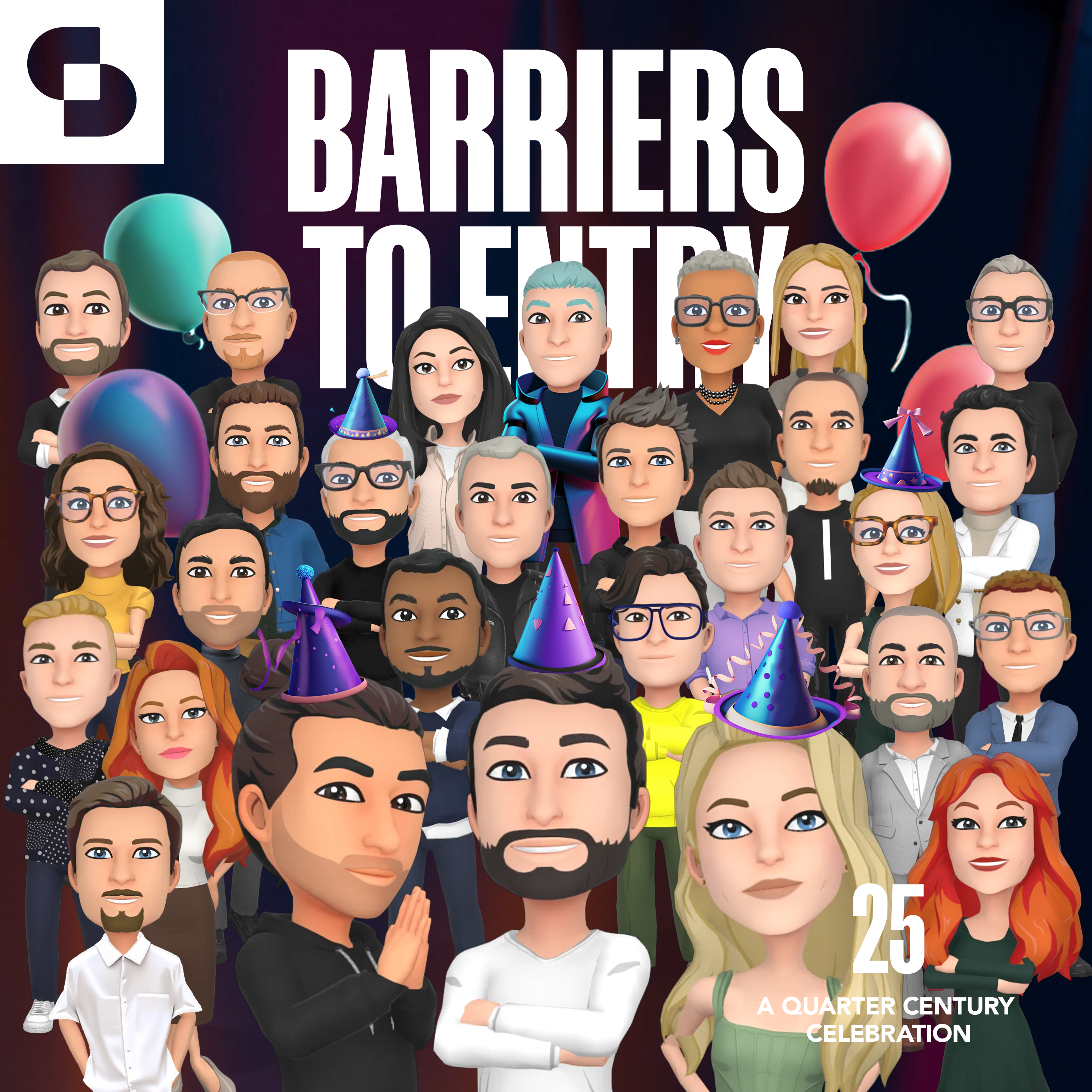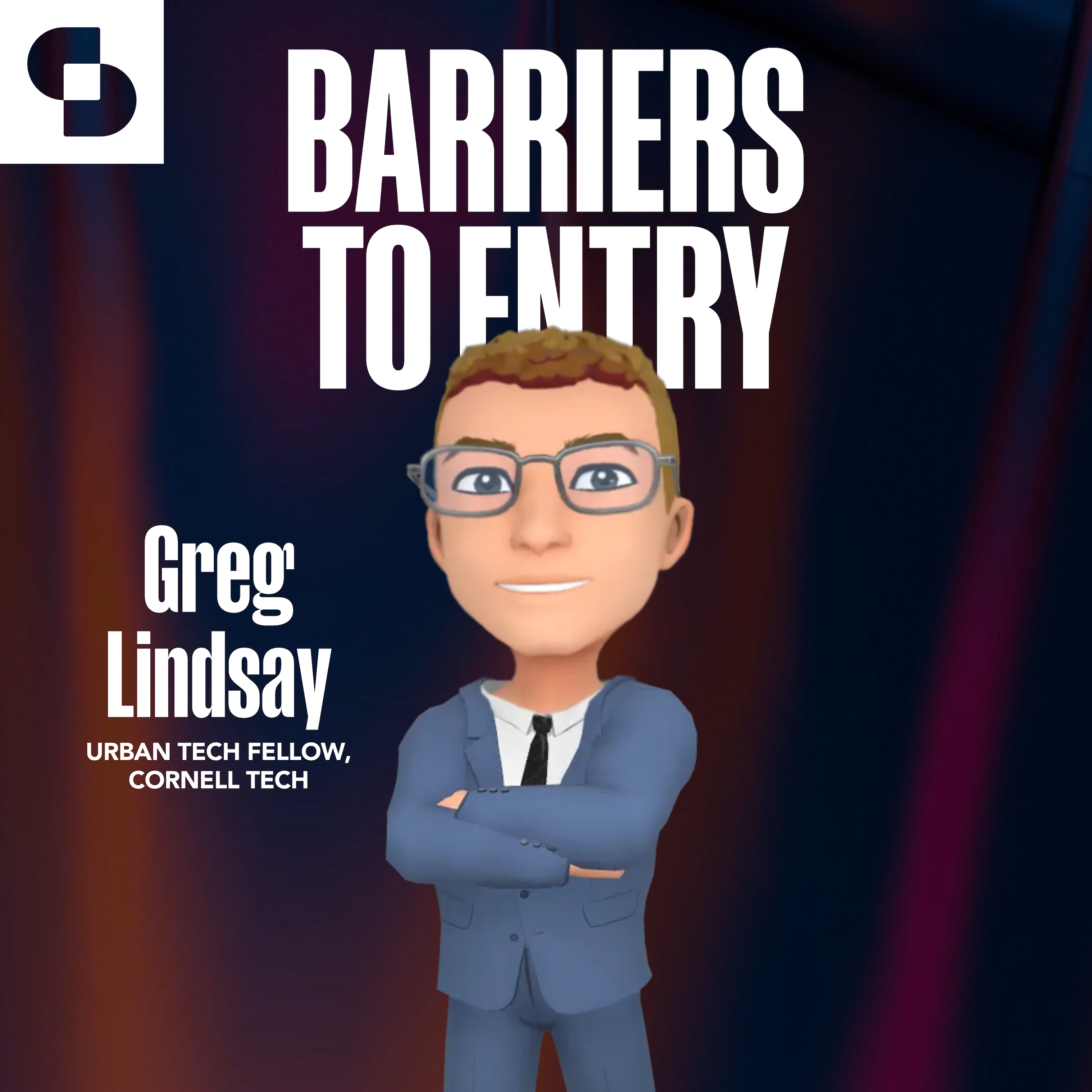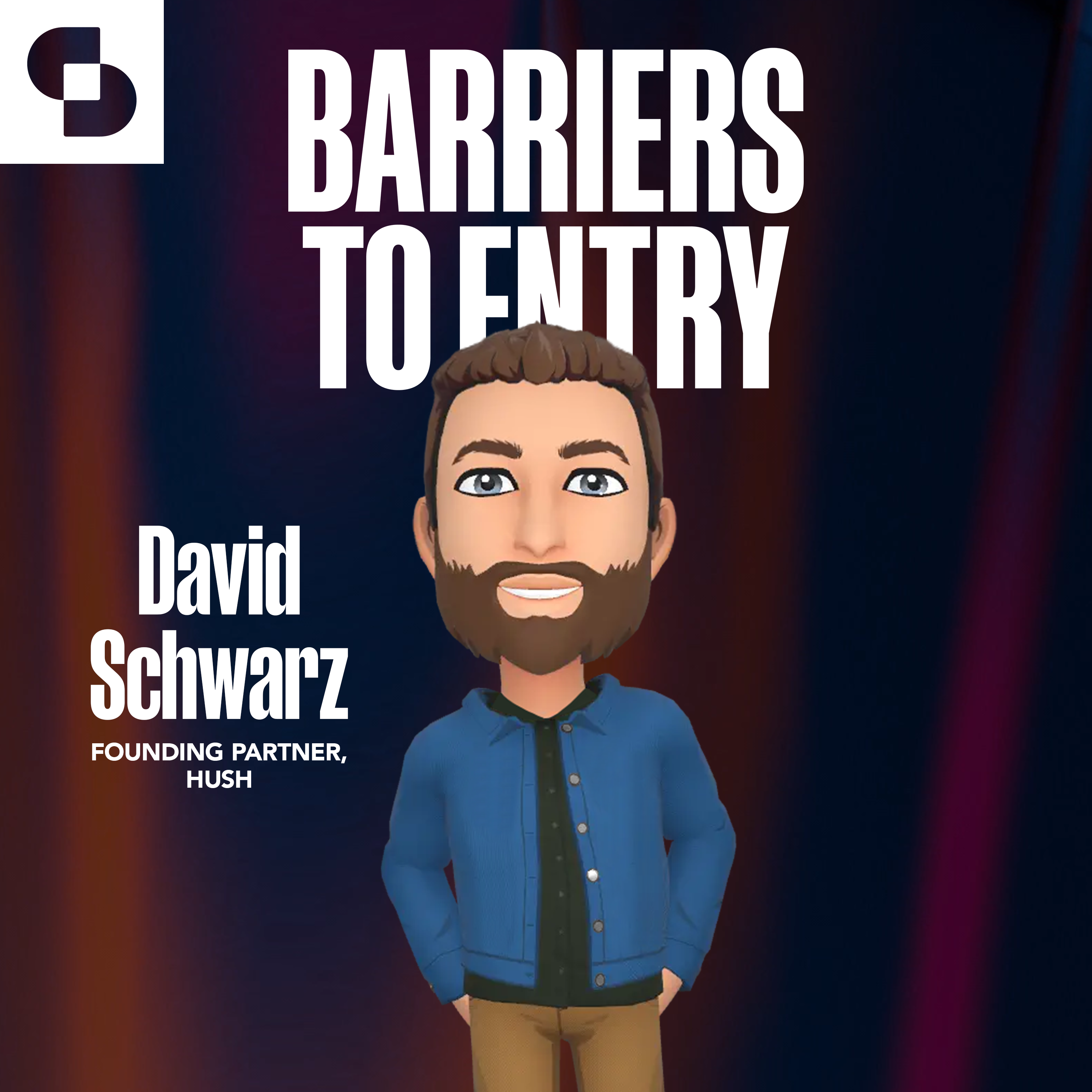On this episode of Barriers to Entry podcast, we’re joined by President and CEO of Heller, Inc and admitted New York Knicks fan, John Edelman. In a wide-ranging conversation, John shares his views on everything from NFT and IP ownership, to the possibilities for the impact of authentic design in the Metaverse, to the future of work, the ethics of tanking in the modern NBA, and beyond.
A must-listen for anyone excited by the potential of what’s to come.
Connect with John Edelman on LinkedIn! Check out Heller’s website for your holiday gift!
Moments to check out;
- The appeal of the metaverse to designers and brands (7:27)
- How the next generation of talent, corporate culture and design will intersect (20:10)
- Re-defining how physical and digital design coming together (34:22)
Connect with our hosts on LinkedIn;
Discover more shows from SURROUND at surroundpodcasts.com. This episode of Barriers to Entry was produced and edited by SANDOW Design Group.
Special thanks to the podcast production team: Hannah Viti, Wize Grazette, Kasey Campbell and Samantha Sager.
[00:00:00] John Edelman: When we don’t realize we’re going into the metaverse and exiting the metaverse, when it happens without effort, that’s when it takes off. I think we’re close, but we have to figure out how to design it so it’s seamless.
[00:00:12] Andrew Lane: Welcome back everybody to Barriers to Entry. We’re new, so if you did not recall, we are the podcast that every episode gets into it with the leaders, designers, and early adopters and influencers who are helping shape Web 3, the Metaverse and blockchain specifically for the architecture and design industry.
I’m Andrew Lane, and with me, as always, are my lovely co-hosts, from the SANDOW Design Group, Bobby Bonnet. Wow. Lovely and the esteemed co-founder at Digby, Tessa Bain. Welcome guys!
[00:00:45] Bobby Bonett: Andrew, so little known fact. barriers to Entry is not a basketball podcast, but I did wanna check the NBA standings in recognition of today’s guest who is the president of the New York Knicks fan club.
[00:00:56] Andrew Lane: And there’s really not much that this guy hasn’t been the president of, or [00:01:00] we’re really excited to have him on.
and he’s even got a personal connection to one of our co-hosts.
[00:01:05] Tessa Bain: It is personal for me. I actually had the opportunity and the pleasure of getting to work with the one and the only John Edelman,
[00:01:12] Andrew Lane: the Cat’s outta the bag
[00:01:13] Tessa Bain: The cat is outta the bag at, uh, Design Within Reach. And you know, it’s a really interesting story. I wanted to work there. We are based out of Toronto, Canada. and design within reach contract had not yet come to Canada and so I thinking this to myself that you know, I am perfect for that job. I am passionate about design, authentic furniture Design within Reach leads that story. They are the leaders in design authentic furniture in North America. And so I, flew down to Chicago, it’s Neocon.
And I developed a business pitch and I was convinced I knew what I was gonna do. I walked in, I was so motivated, I sat down with John and John McPhee at the time, and I pitched them on why I should represent the Design within Reach contract in [00:02:00] Canada. And so that was really the story of, of my, one of my early interactions with John.
But I think my most favorite part about that was if anyone’s met John, He’s an incredible businessman. And so the conversation was, of course, intimidating.
I left their feeling confident, but I wasn’t a hundred percent sure. the next morning I walked downstairs, I’m waiting on the Uber, to go into the Mart and I see John and he looks at me and he says, are you happy? And I was like, well, happy about what? And he’s like, about your job that you got.
And I was like, this is amazing. It was the most epic way to get told that you’ve got a job. And then John got into his black car and I got into my Toyota Camry.
[00:02:37] Andrew Lane: It’s hard to not get a Toyota Camry sometimes too when you call an Uber.
So you can’t be faulted for that. Like they’re, they’re kind of everywhere. Toyota not an official podcast sponsor yet, but, uh, showed up to the reliability on that.
one of the great things about John is that he is a consummate innovator. He’s always looking for the way to push the boundary and to see what’s next and to embrace what’s next.
And [00:03:00] we actually had the opportunity to be on a CEU panel together at NeoCon last year. You know, that really got the conversation going with him about where his head was at with all these new spaces. And so it’s gonna be really exciting just to hear from someone in a position like him about how his company and how he’s thinking as a businessman about the opportunities that this space is going to be able to provide.
[00:03:22] Bobby Bonett: All right, so let’s get into it with John.
Court side with us today is the current CEO of Heller, executive chairman of Crypton and a board member of Chilewich, Be Original Americas and DIFFA when he’s not turning around businesses. He’s at the garden trying to relive the glory days of 1973. Thrilled to have him here today. Welcome John Edelman.
Welcome John.
Welcome John.
[00:03:45] John Edelman: So glad to be here. Thank you so much
for having me.
[00:03:50] Bobby Bonett: So, we’ll get. Metaverse and design in a moment. But I think the first question we have to ask is, if you’re hoping the next tank for Victor Wembanyama this year. [00:04:00]
[00:04:00] John Edelman: Now, listen, we don’t tank for anybody. We are the New York Knicks.
We do our best every single time. And if, all of our starters get injured and we get, last place, I’ll take the recruit but for right now. maybe we’ll trade our picks, but we’re gonna do our best to win this year like we do every year. And like
I said,
[00:04:14] Bobby Bonett: like you do every year in the preseason,
[00:04:16] John Edelman: I’m a preseason guy.
I watched both preseason games. We beginning to end and we did very well. So we got two more preseason games, then we get to go to opening night. So I’m ready.
[00:04:25] Andrew Lane: at least there’s some good consolation prizes this year. So lots to look forward to
John Edelman: Only if you’re the the worst.
Tessa Bain: John, we’re gonna be all over the map today, but let’s start with NFT and IP ownership. most importantly, why are you so passionate about authentic design?
[00:04:44] John Edelman: I spent my entire professional career defending authentic design. I come from the leather business where no one knows about leather.
It’s all your word of what’s true, what’s not. and then I went to Design within Reach, and the biggest issues they had were from copying other people’s designs. So [00:05:00] immediately I was put on the defensive and flushed all those copies away. I joined the Be Original Americas as a board member. I’m a permanent ambassador.
I was the president. and we fight for authenticity to fund the future of design. Imagine how difficult it is to come up with a great design. In order to come up with a great design, you need to fail and failing’s expensive. So if you do a great design, if someone copies it, you don’t profit from it. You can’t produce the next great design.
So it’s a horrible kind of pattern that happens when people start to copy we need to defend authenticity so that we can, support the next great iconic designs. So, in your recent position at Heller, how are you protecting or, better championing authentic design
Yeah, so I’m, fighting anybody that knocks us off with, obviously with aggressive deceased desist notes. I think our reputation precedes us, and I’m trying to teach our designers how to protect their original designs.
[00:05:58] Bobby Bonett: [00:06:00] Andrew and Tess, how does that work when it comes to protecting original design through an NFT or through a digital token?
Andrew Lane: one of the biggest things about it, Bobby, and what a lot of people don’t recognize about NFT is the idea of NFT is that it’s a one of one and it’s very much similar to an authentically designed product in that way. and as John just so eloquently put, the importance of that one of one design is something that needs to be protected.
[00:06:22] And the blockchain actually offers an opportunity to do that in an indisputable way, in a way that shows us with a token that this is a one of one design. That this was originally manufactured on behalf of the true designer, and sold to a particular individual. And all of that stuff can be traced and become a permanent record.
that really creates all kinds of other opportunities for the product in terms of, second life and sustainability, that we’re always excited to talk to anyone who wants to listen.
[00:06:49] Tessa Bain: to unpack that a little bit too, it’s when Andrew mentioned Second Life and Third Life. So we design great products and manufacturer like Heller creates great products.
throughout the lifetime of those products, we can [00:07:00] track now users using blockchain technology. we can track end of product life cycle. so Heller has a fantastic sustainability story of recycling those units and so now we can have an accurate forecast and path of where that product is going all the way up until the end of its life cycle.
[00:07:15] Bobby Bonett: Yeah. So if it’s not clear, Andrew and Tess are working with John on some exciting things, tied to NFTs and authentic design in the Metaverse, and his capacity at Heller. John, when you talk with designers and mention these efforts, how do they typically respond or react? Are they thinking about things the same way you are as it relates to authenticity?
[00:07:34] John Edelman: Yeah, they really are designers, that’s all they had to stand on is their name and their designs. so it’s the bane of a designer’s existence to work so hard to have it be copied. So in the olden days, you’d take a picture of your design or you’d actually take the original design and copy it, throw it in a FedEx, mail it to yourself and not open it.
And that was called a ‘poor mans patent’. if we can move above that and go digital and have a real non fungible guarantee, like you can’t argue with it, it’s [00:08:00] done. it’s forever. I think that’s a great solution. And they’re fighting for solutions. They’re searching for solutions, and this is a great, solution to give them.
[00:08:09] Bobby Bonett: So John, the rules of physics don’t apply in the metaverse. And while that’s appealing to some others are excited by the challenge of problem solving within set limitations, is the lack of, earth based physics, advantageous or does it work against design processes in your opinion?
[00:08:27] John Edelman: Listen, I think it’s all about the individual designer. I think some designers, love it and design these fantasy worlds that couldn’t be created on earth. And maybe some of that falls back to earth and influences our design today. I did broach it with, Frank Ghery and suggested he designed a city in the Metaverse, and I was so excited and I said, Imagine you’d have no, limitations.
All your wildest dreams could be pursued. And he said to me, The rules are why I live. my whole design is based on living within existing rules and then creating new boundaries, but within [00:09:00] the physical realm. So I think it’s different for every. I think it’s my son when he grows up, they’re not gonna care about the rules.
They’re not gonna have them. They’re gonna either design it themselves or live in it virtually. but that’s gonna be different for everybody.
[00:09:12] Andrew Lane: What do you think that tipping point looks and feels like? Like you’re talking to designers all the time. when we look at these principles and the fact that, an established and renowned professional lake Frank Gehry has that point of view on it.
But I’m sure that to your point, there’s the very, opportunistic end of the spectrum and there’s a lot of people in the middle. What kinds of things are you hearing in your conversations that you’re having?
[00:09:33] John Edelman: I’m hearing that they’re excited it’s almost like therapy for some of them to design as a metaverse because they can kind of execute their dreams and they love it.
I think you remember Frank Gary’s 92 years old. it’s very hard to change a direction you’ve been going in and he’s a genius. But to the younger generation, it’s not a question of are the boundaries important? It really is a question of do the boundaries matter at all? Because you are designing in a new [00:10:00] world.
So if you bring preexisting boundaries into a new civilization, you’ll be left behind and you’re gonna have to change your mindset. A Steve Jobs did that by, taking mushrooms, whatever, and expanding his mind that way. But it’s almost that same kind of philosophy of mind expansion, which is gonna have to happen to really, take full advantage of the metaverse.
[00:10:23] Andrew Lane: I love that idea of the philosophy of mind expansion. I hope that’s something we’ll touch on a little bit more as we go along here. The other thing that we think is really interesting and curious if you’ve been exploring is this idea that there’s, outside of design itself, there’s ways that we can, solve problems and test out thoughts and just experiment in some of these 3D, digital environments that can be used for design.
[00:10:45] John Edelman: Yeah. first was 3D printing, right? Which is, almost like bringing the metaverse to us, bringing something from nothing to reality. now this week I work with a great young group, called Jumbo Studios out of New York, and they used [00:11:00] CNC cutting to cut layers of foam to put on top of each other to create the shape of a chair, to create my sit to see if it was comfortable, right?
So imagine if they could have done that virtual. And my perfectly formed avatar sat it to see if it was comfortable. that’s not that far away. They’re totally connected, but it would’ve saved months of development. And I think exploring those shapes of exploring those fits and developing a way to see if things work virtually, not only is it saves time, it’s good for the environment, there’s less waste and probably end up with a more, perfect, finished product.
[00:11:42] Bobby Bonett: I think we need to get a look at that avatar, John, to get a sense of of what virtual John looks like. I don’t, I think
[00:11:48] John Edelman: it’ll be scary. It has to be just, the only way for it to work is, has to look exactly like me, right? And every way, like it has to be like, I guess I get scanned or something. But that’s a scary thought.
Bobby Bonett: quality and craftsmanship are [00:12:00] what set luxury and premium goods apart from everyday products. are you feeling like luxury brands are getting it right in the metaverse today?
[00:12:09] John Edelman: I think they can afford to execute their vision in the metaverse, right? So you think about a luxury brand, so much of their money is put into marketing, whether it’s a Louis Vuitton to or Hermes. and I think they are getting it right. I’m not an expert in that, but I can see that they’re investing in their image for the future.
They’re gonna open up their virtual stores on the virtual 5th Avenue, and they have the dollars to invest and they’re getting press from it. It’s building, I think they’re actually the leaders in that world as far as I can see. You guys feel the same?
[00:12:39] John Edelman: I would agree
[00:12:40] Bobby Bonett: there. Yeah,
[00:12:40] Andrew Lane: I would say so. Do you think that Virtual John needs some virtual, Hermes, I guess is where we go from here. That’s a good, it’s a good
[00:12:47] Bobby Bonett: question. I’m not flash, so I think I’m gonna go like virtual J Crew, but just have it fit real well and see how it goes.
I don’t need virtual luxury or even real luxury. I think it’s all gonna depend. I think that it’s fun to go in [00:13:00] initially and create the flash and create the glitter and glam to get people interested, but then your own lifestyle, unless you’re gonna be somebody different, I think it’s gonna be who you are.
[00:13:10] John Edelman: Maybe just with a little more freedom. if I’m not wearing Hermes and Vuitton now, I’m not gonna do it in the virtual world. I don’t think that’s just me.
[00:13:17] Bobby Bonett: I think that’s exactly right. In web two on social media, we’re putting out an image of ourselves that we aspire to be.
And I spent more time than I’m willing to admit fine tuning my Bitmoji on Snapchat the other day. and you see the brands on there and I’m looking at the clothing options and I’m a guy who wears like Nike. I’m gonna choose the Nike outfit over the default Snapchat outfit. And at some point I’m sure the question will arise, Will I pay a dollar or a fraction of a digital token in order to access that premium good.
So that I’m continuing to push forward that vision, that image of myself that I want to.
Andrew Lane: Well, John’s a watch collector, right? Like you, you collect watches in the physical world. how does that collector mindset transfer in the way that Bobby’s [00:14:00] talking about in the way that we’re thinking about what our virtual avatars need?
does our collection just grow into the digital space?
[00:14:06] John Edelman: I don’t know. I think what I really wanna do is take my collection And develop, non fungible tokens that represent what I’ve already done and take it forward because it’s so personal. and if it’s not super hard to find, so if you can just buy it, never be interested in anyway.
I don’t know how to go out there and search for things yet in the metaverse, how do you find a 1970s watch when in the 1970s this stuff wasn’t invented? So I think collecting for me is almost a bit of, going into the past versus the metaverse to me is looking towards the future.
[00:14:41] Andrew Lane: So I love your Metaverse collectible search engine. It’s a good time to remind you that all the business ideas generated on the podcast are property of the podcast, but yeah, that’s an incredibly interesting point is that we haven’t yet seen interoperability.
How do these metaverses function together? how do you get centralized within that and say, Hey, I really [00:15:00] wanna find the rare stuff. I don’t wanna find the stuff that Snapchat Bobby’s wearing. No offense there, Snapchat, Bobby, but how do I find, the ultra rare? how do I really authenticate things that are meaningful to me because of the fact that they’re unique?
that’s a really interesting, future state that we’re not quite at yet. Has anyone seen anything like that?
Bobby Bonett: I think it’s ultimately gonna be how and where we ascribe value as members of the metaverse. what might be ultra rare or have the feeling of ultra rarity in a metaverse, it’s going be a lot different than the physical world.
[00:15:30] I can imagine if I’m walking around in a metaverse and I see something from Hermes lying on the ground, my initial reaction might be, Oh, this is probably something that’s common. I don’t need to pick this up. I’m going to leave it here. And breaking down that boundary a little bit in terms of where is their value to be had, is a problem to be solved ultimately.
and we’ll change what is exciting and valuable and limited edition in the metaverse versus the physical world.
[00:15:51] Tessa Bain: We had a really interesting conversation with a product designer, and during the pandemic, he was using his Oculus and watching Netflix with one [00:16:00] of his family members.
And so they’re sitting in this Oculus living room and in the living room he’s I’m looking around here. I am a product designer and everything is like garbage, in terms of furniture and in terms of design. And so he’s sitting on this idea saying there’s a real opportunity to represent myself and my interests in my space.
And that extends itself over to furniture. when you walk into someone’s home, talk about collectibles, they might have invested in those pieces of furniture. And for that community that says something, I wonder if that has a bit of an opportunity.
John Edelman: sure it does. that’s to emulate someone else’s lifestyle.
[00:16:36] I get that. That’s super cool. But that’s almost to an influencer stage. But how do you find a four coaster Eames chair that was produced before OSHA made, put five coasters, casters, Excuse me. I think that’s a different way of collecting, and I think I see the metaverse as a way to authenticate your existing and then hopefully take it with you, [00:17:00] because I don’t wanna leave home with all my favorite stuff and I don’t need to go to the metaverse to get new stuff. How can I wanna hang out there with new people and bring my old stuff?
Tessa Bain: Yeah, and what I think you’re talking about a little bit is the wallet, which exists right now. And so you have Instagram, for example, allowing users to post NFTs that they hold in their wallet and share those in a very social setting.
[00:17:20] And so that might be, a further iteration of kind of that concept.
John Edelman: Yeah, totally.
[00:17:27] Andrew Lane: That’s interesting, even to see the way that our friends at places like Christie’s and Sotheby’s have embraced the space and the kinds of things that they’re thinking about that and respect as well. So the roadmap is definitely there.
[00:17:37] John Edelman: And I think what’s so interesting is all these companies, Christie’s, Sotheby’s, et cetera, they have no choice but to embrace it. It doesn’t mean they know what they’re doing, They’re just, they’re getting their feet wet so they can say they’re doing it. It’s, you’re
[00:17:49] Andrew Lane: not supposed to let the secret out that nobody really knows what they’re doing.
[00:17:54] John Edelman: Yeah. But that’s the exciting part is that unfolding as we watch, you talk about, an amalgamator [00:18:00] to hunt, in the meta world. who thought we did a smart TV and have all your apps in one place so you can watch Hulu, Netflix, Apple, whatever it’s gonna be, on the screen that wasn’t possible.
that part, some of it has to catch up. We don’t know exactly how we’re gonna access things in the metaverse and from what different. versus, I wanna live next to Snoop Dog. What’s not possible? Let me all create a new Snoop Dog house and be on his new block or something.
I don’t know how that’s gonna fall out, but you, I can’t live next to him in Malibu either. we’ll see what happens.
Bobby Bonett: I want to harken back to one kind of the anecdote tests you were sharing about the interaction you were having with the product designer. And I’d wonder how John, how you would approach the question about, you have, limited edition or limited availability, and you have luxury and you have beauty.
[00:18:43] But when you think about furniture in a metaverse, are we still going to be talking about utility?or will that lead to a different way in which product designers are thinking about how they’re developing office products?
[00:18:56] John Edelman: I have a far out view on this, and I think it depends [00:19:00] how immersive your metaverse experience becomes. So are you actually gonna sit in that, virtual furniture and when you have a way to feel how it feels, until you can feel it, it doesn’t matter.
It’s purely visual. It doesn’t matter what the design is, if it’s not hitting your lumbar or whatever it’s gonna be. But as the technology progresses and we immerse ourselves and actually feel our surroundings, then it has to change. so why bother making a comfortable chair now in the metaverse?
it doesn’t really matter. You do it for this overall look. I’m sure 80% so gonna be inspired by Sarrinen. Cause people believe that’s what the future’s gonna look like. Still . I dunno, I think comfort happens when you need comfort. we are creatures that perform to how we’re incentivized.
[00:19:43] John Edelman: If you’re incentivized through comfort, then you design comfort. If you’re incentivized through beauty, design, beauty, if you get lucky enough to do both, you do both. But you know what’s actually needed at the moment, it’s much more visual.
[00:19:51] Andrew Lane: It’s interesting when you talk about those incentives because, you could make a number of arguments, but just for the sake of the conversation, I’ll make the argument [00:20:00] that the metaverse is incentivized by interaction, by being social.
what kinds of designs and what kinds of spaces and structures and shapes and details are we going to need to incentivize that kind of interaction. right now, I think a lot of it is fainting beauty and comfort because we’re familiar with it from the physical world, so that people and their minds will feel at ease when they step into these spaces.
we know what a chair is, but what’s a non chair when I actually don’t need to sit because my legs never get tired.
what kinds of creative inspirations are gonna come from really starting to understand the way that people use these new spaces. And I think, Bobby, you were starting to get there. Future of work is probably gonna be one of the leading areas in how this comes to be because it’s one of those instances where our interactions are, a little bit more like forced, let’s call it, because we’re getting together with a group of people on a regular basis to try and create outcomes.
How is all this gonna come together in your mind, John?
John Edelman: I love the idea that we can go to [00:21:00] a virtual conference room and it can be in the 175th floor of a New York City building that hasn’t been built yet.
[00:21:06] And we’re looking the view of everything beautiful in the city. But how am I gonna pay attention to the meeting? it’s distracting. Or do I want to be in like an immersive color that inspires me to calm and listen and pay attention? I don’t know. That’s what’s so exciting. That’s what I keep going back to is it’s all brand new.
Am I sitting in the same room with somebody I the same planet with somebody? what’s required to create the best level of communication, which means listening and projecting. So I don’t know what it is yet. I know that people aren’t going back to the office five days a week, whatever the hours are for a really long time.
[00:21:42] John Edelman: I don’t care what people say. I think it’s all changed. So how do you create the feeling of connectivity in a virtual world that creates, a vibe of collaboration and learning and mentoring? I think that’s what it’s, it has to improve it. It’s gotta improve it, right? there’s no question it wasn’t [00:22:00] perfect pre pandemic.
So now you add a bunch of different factors. You’re at home, you’re separated, you might be suburban versus being urban. how do you maximize the interaction to benefit everybody? I’m not sure, but what kind of room is that? it’s certainly not something where you’re constantly distracted.
[00:22:19] Tessa Bain: It brings up a really good point. we talk a lot about inclusiveness of people that are physically in the office and then people that are joining in virtually, and how do you make that communication really seamless. I have no answers, but how do you design a beautiful space and what does that research look like? And that’s why we always defer to the experts, the designers.
John Edelman: what does that look like? everybody’s favorite spot in the office today is the phone booth. Where it’s completely unadorned. There’s no distraction and no one hears you outside the room. So why does everybody like that so much? they choose that over a conference room.
[00:22:49] I think that’s really interesting. It’s a focused space. How do you elevate that? How do you encourage the connectivity? I don’t really know. I was in California at a huge office. currently they [00:23:00] have more phone booths than people coming to the office.
They a building that holds 500. They have 150 phone booths and 50 people are coming to work . And even in the empty office, they choose to work out of a phone booth sometimes.
[00:23:11] Andrew Lane: I think that focus space is something that people have missed for the last two years, though, working with kids and families and other distractions around the house.
So you give up the need to commute, but you also lose the ability to isolate and to focus in a way that’ll allow you to potentially be productive, in the way that you feel like it.
[00:23:27] Bobby Bonett: there’s something scary about that too, though. we’re talking about designing an office that has the right tint of blue that will lead you to feel calmer.
But, I’d be a little worried about an overengineered metaverse that is set up in such a way that we’re reducing any sort of, I don’t know, variation in your day that might lead to a different type of creativity and that’s what like, that’s why I, I use the phone booth when it’s available more than I should, but it’s also kind of a, a crummy place to work, in some instances if you’re supposed to be coming to an office [00:24:00] to interact with other people and have these chance encounters and have these moments where they were unplanned or they weren’t overly engineered.
And John, I think you feel passionate about the idea of enhancing and enabling creativity as a table stakes feature for somebody to want to go to a metaverse three days a week, not just once every three months.
John Edelman: I always go out to Steve Jobs, but he used to like to have meetings where they went on walks.
[00:24:25] How do I wanna walk with you and be in different places? . And is it a real walk or is it a virtual walk? Are we seeing the same thing or different things? So in the metaverse we can probably go on a walk and get inspired or see the same things at the same time. That’ll inspire creativity, inspire our learning, inspire conversation.
And that’s pretty cool. Zoom doesn’t do that, right? Zoom is a short term, one-on-one thing. So is the phone booth. How do you create, a young person in Singapore, working with a young person in Austin, Texas and have them feel about that they’re in the same [00:25:00] environment, sharing the same effects?
we’re just at the very beginning. Right. Everybody agrees with that. how’s it gonna fall out and how are you gonna feel it.
Andrew Lane: I think that one of the interesting factors in this, your walk, example is a good one.
[00:25:11] We still have this confinement to the rigidity of a five day a week, 40 hour work week. what we’re talking about and a lot of the ideas you’re sharing is something that’s a lot more fluid, where it’s about the utility of spaces, the ability to find optimal work environments. what’s the design opportunity there to really start to think And is it possible that good design could be the way for us to reimagine truly the way that we interact with our workselves as people?
[00:25:39] John Edelman: Good design will be the way, It’s the only way, right? it’s today’s, Sarrinen’s, Eames is, I, the classic designers that, that have a vision of the future, things that last forever. modern design is what I call it. But it could be different term than modern going forward. But our spaces will be designed, if they’re not designed, they’ll be chaos.
Right? And people [00:26:00] won’t ever connect. how do people like to interact? What is the best scenario? What makes them feel the most connected in a completely disconnected environment? And that’s not an easy question to solve.
I mean that people developed the open office plan and everybody did the open office employees hated it, they had to fix it. They built the phone booths and this and that. to answer your question, it’s a hundred percent about design. And the question is which design and how people wanna go about it. But it is, it’s purely designed,
[00:26:27] Bobby Bonett: That’s a serious responsibility for designers too. Starting to think about metaverses and virtual worlds when they’re used to thinking about physical products or physical spaces.
[00:26:38] John Edelman: Exactly. I think I said it before, how do you expand your mind to get there?
Cause it’s not something you’re familiar with. It maybe our generation won’t be able to do it. it may have to fall in the next one that knows nothing different. the generation that doesn’t know anything but wearing an Apple watch, having a device attached to your body, that changes a lot of things.
we started having the phone never leaving our body, but they actually wear an Apple [00:27:00] device or a sleep measuring device or an exercise device. It’s that interaction with technology that’s gonna allow for that kind of, herculean and jump forward in the metaverse because it’s not gonna happen if you’re not, physically engaged at some point to go to the next level.
[00:27:17] Andrew Lane: it’s interesting cuz that generation that you’re talking about, like they’re not far out from being a part of the workforce. and being the people who potentially join design firms and architecture firms and become these, designers that you’re talking about, as the CEO of a company and talking to a lot of other leaders, is that a conversation that’s happening how do you attract and make a place for this next generation of talent?
[00:27:39] John Edelman: Yeah, I’m just a small fish in this world at the moment with my little baby company Heller, it’s tiny. So I’m just trying to get people outside, I’m the opposite with Heller Furniture. My concept is, let’s take the meeting outside and walk outside and sit outside. and the definition of me for modern is, furniture that can go anywhere, whether it’s a skyscraper, a castle, or an old [00:28:00] barn.
And I’ll add to that, inside or outside. And that’s all I’m trying to do. I, young people are coming to me these days cuz they want to learn. I’m not worrying about, bring ’em to the office or not. they’re coming in.
[00:28:09] Andrew Lane: what do you think it is that you have the ability to teach them that’s gonna be compelling for them given everything that’s changing around us?
[00:28:19] John Edelman: I think the ability to reflect intelligently on the past 25 years of design and the business of design gives me a little bit of a help looking at the next 25 years. And we’ve made mistakes, we’ve done things right, and how do you balance that out to make more correct decisions than incorrect decisions going forward?
[00:28:39] Andrew Lane: I think people like that, that don’t know your history or doomed to repeat it as is, I think really powerful. How do you rationalize that with being such an optimistic Knicks fan?
John Edelman: it depends how far back you go in history. So History Repeat itself will apply the Fibonacci code to when it comes back again and we’ll jump on it it’ll all be good.
[00:28:57] Andrew Lane: amazing. I had to throw that [00:29:00] call back in there.
[00:29:03] Bobby Bonett: John, can you talk to us, a little bit about just wrapping our discussion about future work and hybrid work or metaverse work. Talk to us a bit about corporate culture, and how, or where corporate culture may have suffered a little bit these last two, three years and how designers can think about bringing back corporate culture maybe through the lens of designing for virtual spaces.
[00:29:25] John Edelman: Yeah, I think corporate culture has taken a huge hit. and I think no one knows how bad it got hit yet. I think there’s still riding off pre pandemic visions of what the corporate culture was. But when you bring somebody into an organization that’s never been to a company lunch or seen a CEO come in hung over or whatever, it’s gonna be the old school stuff that we all kind of caught glimpses of.
we’re gonna have to have some kind of virtual way to understand. The vision of the, entrepreneurs has started the business. Cause if you lose that energy, if you lose [00:30:00] that passion for product or design, or for industrial happenings, wherever it’s gonna be, then it’s very hard to develop that corporate culture because it is these, mid-size companies, small companies in America are the biggest employers in small companies are run by visionaries.
[00:30:16] John Edelman: How do the visionaries get their message out there and how do you become part of it? And how do you get your talent assessed? How do you know if the corporate culture is actually working? It’s not just about productivity, it’s about mood, it’s about passion, it’s about dedication. I think that’s very difficult to do.
Totally separated. So they’re gonna have to design a world in which we can hang out a bit. And it’s not all about how many widgets did you produce today? Can you produce more widgets tomorrow? I think that’s antiquated. The Jack Welch philosophy of management is also relatively antiquated. it’s what’s next.
And they talk about quiet quitting and all these different things. They don’t wanna work, 75 hours a week anymore. So how do you make the most of those 45, 50 hours if you can get ’em to do it [00:31:00] And what inspires them to do it? It’s not sitting at home with your dog barking to go outside, you’re losing wifi its, that’s not what creates, an environment to go and do more things that we’ve done before for your organization. And that has to be figured out.
[00:31:17] Bobby Bonett: Yeah. Seeing people’s faces, I think was a nice way that you put it the other day, John, that the way in which we interact right now is transactional and you see somebody’s face when you’re asking them to do something, rather than seeing them in the hallway and having a quick collaborative discussion.
They can put on a temporary face on the computer, but I’m telling you what, you walk through your own customer service department. And you see their faces in the phone and you hear the tone they use. And, it’s very hard to replace, Design within Reach. I tried to spend an hour a week on the phones in customer service with my people.
[00:31:47] John Edelman: And I could have done it just by listening in from my desk, but it wasn’t the same. I wanted to see if they looked calm, doing it, if they were natural, if that was their gift. and it wasn’t easy to tell just from listening. And if they’re not in the [00:32:00] phone and they’re in the in between calls, are they crying?
Are they going through a nervous breakdown ? you know what, what’s going on? And can the metaverse be broader? What if you could see the whole company? it’s gonna have to be a place where you can walk down the hallways and, see who’s going to the bathroom or, getting a drink of water from the founder, refreshing their coffee even if they’re not with you.
And John McPhee and I at Design Within Reach, we take our office to the kitchen for half a day a week and just see people getting coffee and hang up with it and ask a few questions. How do you get that back? and that it can be done right. But we have figure out how
[00:32:37] Tessa Bain: It’s that social collaboration element that we’re missing.
Which is exciting too, because that’s when you think about the pillar of a metaverse versus just maybe virtual reality and not to take away from VR cause it’s super important, but one of the founding pillars of Metaverse is social interaction. I think that’s probably a very exciting opportunity for future of work once we can get it to the right level. [00:33:00]
[00:33:01] Andrew Lane: And even just broadly future of design as well. how do you find a new way to replicate the CEO being able to sit down in the lunchroom and watch people get coffee? this next generation, you’re talking about new CEOs who find new ways to have those same sort of, of interactions.
Tessa Bain: this is interesting cuz we’ve heard applications that the metaverses be used for onboarding, and employee training. you have the CEO coming in to talk to the new employee, but of course it’s scripted, loses a little bit of that off the cuff nature, which I think is important.
but those are early iterations of that type of access that a CEO could have.
[00:33:31] John Edelman: Sure. It’s also one way, right? Once you say recorded, I’m like, that’s a great onboarding, right? You will do this way every single time. you know, I just sit at the desk where the interns, some people can’t speak at all. They’re so nervous and some people can’t stop talking, you know where you’re from and what college you going to.
What’s your passion? why are you here? And then all the other people listen in And there’s something cool about that, and I don’t think it’s gonna go away, but it’s gonna come from your generation where you don’t know much different,[00:34:00] than the new technology kind of seeping in.
I think all the Wall Street firms demanding everybody’s back in the office, Oh, we’re so successful. Everyone’s back in the office and you really ask them, And it’s a group of people Tuesday, Wednesday, Thursday at best working way fewer hours, and honestly being less happy. It’s just to, satisfy a bunch of old dudes in the corporate, C-suite saying, Oh, we have to have the office back.
[00:34:21] John Edelman: It’s just, it’s not gonna be the same. I think what you guys are doing is the future, but it’s part of evolution. And when we don’t realize we’re going into the metaverse and exiting the metaverse, when it happens without effort, that’s when it takes off. I think we’re close, but we have to figure out how to design it so it’s seamless.
Tessa Bain: The natural adoption of Microsoft teams and Zoom over the pandemic is the perfect example of the rate of which we can naturally adopt something without even realizing we’re doing it.
Andrew Lane: The earlier, example is the iPhone when all of a sudden people realized they could do all those things from their pocket that they never could do before, right? that was a [00:35:00] fundamental shift that really came from one piece of technology.
[00:35:02] And it happened at a time when not everyone was ready for it. Everyone was just trying to figure out how to type a little faster on their Blackberry keyboard, I think we’re at another one of those phases where even a product is gonna leap so many things so far forward really quickly, that it’s exciting to be here for it.
Tessa Bain: Let’s bring this back to design. from the perspective of a furniture manufacturer, how are we going to use great design to attract people to spaces in real life or IRL and also in, digital worlds?
John Edelman: Tess, the design is probably gonna have to take into account, Virtual interaction.
[00:35:38] So you might be designing real world product to facilitate, metaverse interaction. So I’m sitting in an Aeron on chair, but when I’m virtual and I’m walking, maybe the new version of the Aeron chair will simulate my walking. I always go back to the movie Ready Player one they had a place where it could go and become part of the metaverse. [00:36:00] So maybe the furniture has to translate from material where we’re all sitting and working together to, at the flick of a switch into the metaverse and help us have that experience and make it seamless.
The furniture rather than having a USB port has to be much more sophisticated maybe the concept of the chair today is where I hate technology and furniture, maybe won’t have a choice, but to have really forward technology in the future.
[00:36:25] Tessa Bain: Yeah. Or a different definition of ergonomic, or it could be both. I think it’s exciting too. you could have, identifiable real world design, that we find really beautiful.
And then to your point and evolved version of that tech.
[00:36:40] John Edelman: Exactly.
[00:36:40] Andrew Lane: Or your entire home office becomes one device. The way that the Peloton stood for home fitness there for a while,if you’re sitting with your associate, you say, Oh, let’s, it’s tell meeting with Jimmy and Taiwan.
How is that facilitated? I think you’re gonna have to design a couple things.
[00:36:56] John Edelman: One is you’re gonna design a place to meet, you’re gonna design furniture in your own [00:37:00] environment to facilitate you getting there. So you’re comfortable, I know you design an extension of the home office in the metaverse so that you’re not changing everything, but you’re extending versus leaving.
I don’t think people are gonna leave their office. They’re gonna extend the office. It’s like going to the new edition they built or the new, the new commissary. It’s like going to a different room in the building. It just happens to not really be in the building. I can understand why folks question whether a metaverse component to an office and designing for a metaverse.
[00:37:31] Bobby Bonett: Is just something silly that we’re talking about right now. But when you think about the tools we’re using and the way in which we’re trying to force functionality on those tools to replicate the experience you get in an office, I don’t know if y’all did those Zoom happy hours early in the pandemic.
Let’s all get on a Brady bunch Zoom call and awkwardly drink a cocktail for 15 minutes. Or create-
[00:37:52] Andrew Lane: sometimes there was a PowerPoint slide too, Bobby, that had some fun games on it. Don’t forget PowerPoint slides.
Bobby Bonett: Yeah. the Cats channel and Slack, [00:38:00] which all serve a purpose, but you’re trying to stimulate this artificial chance moment.
and obviously people want it,and the tools right now are inadequate. They’re not designed for it I love John’s point. on the extension of our world or extension of our physical space.
[00:38:17] Tessa Bain: It’s almost like I can. Compare it to how I feel about my Facebook profile. I hate Facebook and in a way I’m not the entire brand itself, but let’s just call it the digital identity part of it. I really just go on it to clear the notifications, and so it’s a lost, product for me. But why do I keep it?
It’s a digital identity. It’s my extension of myself in this virtual space. And so let’s blow that up. that’s exactly what you’re talking about.
John Edelman: You’re gonna hire against Gensler to design your new office. And it’s part of the new offices. Oh, what’s the meta office look like? It’s gonna be just part of the original design. you don’t have to ask them to do it. It’s part of the deal.
Everybody’s gonna have to have it and Oh gee, I was in Gensler’s conference in the near day. That’s amazing. the [00:39:00] meta or the reel I was in the. Oh, you should see the real one. I was in the real one. You should see the meta one. I think it’s gonna be an extension of the brand, philosophy.
Having this discussion is making me think about how it’s gonna work out. I really do think that’ll be, it’ll be much more of an extension than someplace different.
Bobby Bonett: It hearkens back to the rule of Web 3, when were at mass adoption when you don’t realize you’re in a metaverse.
it’s a metaphor we used to have. In the office where you just went to the office every day? For me, I got on a train, I walked through Manhattan up to my office, took an elevator, sat down, and I didn’t really think much of going to the office. It was just part of what was expected.
and then we lost that expectation over the course of the pandemic. I was forwarded one email from, a corporate communications team that was imploring its employees to quote unquote pop in a few times a week. what kind of return to office strategy is that?
in order to really nail it here, you need to think about what’s a way in which, at least through the lens of work, I’m transitioning into a metaverse, I’m transitioning [00:40:00] out of a metaverse transitioning into the, virtual Gensler conference room that I’m transitioning into the physical Gensler conference room.
[00:40:05] Bobby Bonett: And all of this feels natural. It feels day to day. It doesn’t feel forced, It doesn’t feel contrived.
[00:40:10] Andrew Lane: It’s truly a pop in to, play on those words that your comms folks had used there. I think, John, to your point, one thing, like we’ve talked to a number of folks about is this idea that these spaces can be used in concert with the physical space.
To be able to experience, a showroom or, products or type of an experience in a metaverse setting. How can you create something that’s gonna make people only feel like the real physical experience is even more exciting, even more desirable, to go to. So there’s, a marketing and a brand engagement level, when you think about it in that way as well.
[00:40:44] John Edelman: Sure. I’ve been out selling furniture and I’m carrying furniture up and downstairs and in the elevators and it feels so 1940s, I would love to have an alternative. We’re just not there yet. we are still on most cases, operating [00:41:00] so far below our current technology level, what’s available.
we can’t even board and deboard airplanes any differently than we did for 50 years ago. And now we’re asking people to, go to a virtual airplane, into a virtual, conference room somewhere. These are huge jumps and we’re leaping over and leaving a lot of unfinished technology behind us and so some of that’s going to tie together and create a more cohesive.
process, but what are we gonna skip over because we’re gonna leave a lot of stuff unfinished or just a lot of it’s not gonna get right.
[00:41:31] Andrew Lane: There’s an interesting exercise there to say what should be left unfinished as well. I think there was a couple votes for the zoom call on this discussion, I’m sure that there’s things that we’re living with every day that we’re not quite as happy with it.
We do have an interesting and exciting opportunity to start to skip over. I often use, the comparison to a lot of nations in the world where they’ll never have a desktop computer. They’ve gone right from having nothing to having a mobile phone with internet access. and they’re not really gonna have the experience in the [00:42:00] middle.
they’ll never know the joys of a dot matrix printer or dial up internet in their home or any of those things that we experienced in the last 25 years. that’s the way that a lot of this progress can happen and it doesn’t always need to happen in the developing country, with the explosive growth that we have around tech right now.
[00:42:17] John Edelman: Yeah, no question.
[00:42:18] Tessa Bain: Can I jump back? I would love to get your take on this question, John. you talked about the boardroom of Gensler and the boardroom in the Metaverse that Gensler has as well. And you’re saying it’s an extension of one or the other? not to be crass, but my background being in furniture sales, immediately go, who sold them the Metaverse Furniture.
Are we, are you giving that away for free? Is that an extension of the investment they’re making in the physical space? what is, from your perspective, what does that look like? Is that a revenue stream? Is an,
[00:42:48] John Edelman: Yeah, I think it’s a total revenue stream. So I think the same kind of physical distribution system will probably still stay in place.
So Gensler designs your office. They go to a, Herman [00:43:00] Miller, a Knoll, Steelcase also whomever to buy their furniture from. They’re like, Oh, what’s your solution for the metaverse? what’s in the toolbox? to use in our new virtual conference room as well as the regular conference.
Like, Oh, have you gotten the, the freedom chair done for the meta? what’s different about it and how do they link to each other? So I think you’re gonna have two different kinds of designers. Interior designers don’t make all the furniture, don’t make all the things.
They’re still gonna go to the vendors If we can keep the same kind of system going, it gives designers a chance to keep designing and making cool stuff.
Tessa Bain: Yeah, I think it’s really interesting. I could see it working that way and following the same sort of, Course or path.
One of the things that we hear about when we talk to furniture manufacturers is that there’s a value to physical goods because of the amount of time to produce, because of the luxury goods and materials and, all of the design hours. do you think it would follow a similar pricing scheme?
[00:43:54] Tessa Bain: Do you think it’s something different?
[00:43:55] John Edelman: I have to think. It can’t follow the same pricing scheme. It doesn’t seem to [00:44:00] make sense. Herman Miller spent, what, 17 million dollars designed their last task chair and with one before this last one they created one of the great chairs of all time that it cost a hundred grand to design the best chair.
If we’re not talking about comfort , and it’s purely visual. How do you judge the value of an artist? it’s by what people like the most, No, I don’t think it’s gonna follow the same pattern. Let’s say you do your whole conference room in, Herman Miller Furniture, there’s probably an add on at a small cost for the virtual version, if you’re thinking of it as an extension and keeping the same kind of corporate vibe in that next world, you would take an extension of what you designed in the physical world. to the metaverse. I would think
Tessa Bain: Do you see Heller stepping into, or responding to that market demand.
[00:44:42] John Edelman: I do, I wonder if you go for a walk outside in the Metaverse, are you buying outdoor furniture or are you just floating? that’s the big question.
are we gonna float or sit or strap ourselves in? or I don’t know yet. Well,
[00:44:56] Tessa Bain: maybe not for outside, but I absolutely could see the [00:45:00] value of a Studio 65 kiss chair in a lobby, as part of an installation and something that I think would be really beautiful in both the physical world and digital world.
[00:45:10] John Edelman: So do I, I think it’s a beautiful artistic piece. I get it. Yes, We’ll be part of that. But the other piece, the more functional, highly functional pieces, I think don’t have tons of value in the next, virtual world. I think you’re gonna get a little more fantastical and just a little bit more free.
Andrew Lane: What are the designs that become the iconic designs of a world that’s not of the physical right The different designs will find different opportunities. And there’s actually a real scale opportunity there as well that might not exist in a physical world because of how many metaverse environments there’ll be.
[00:45:47] Because of how broad and vast that, world could become. You might actually find that while the price points are lower, the volumes could become much higher. Which is another interesting consideration point around these designs.
[00:45:59] John Edelman: [00:46:00] Yeah. No longer you to worry about the cost of moving furniture.
from one, world to the other. Or a supply Or your furniture could be programmed to evolve every 30 days into something different.
[00:46:14] Tessa Bain: I think it’s democratic design too.You have the opportunity to educate and give access of good design to more people, which is exciting.
John Edelman: Yes, you have to have the means to enter the verse to enter the world. . So what is the, what’s the barrier to entry?
[00:46:27] Just to experience the metaverse,
[00:46:31] Bobby Bonett: You also go back to the first movers will have obviously an advantage, but also the luxury brands or the brands with brand equity will have an advantage just as. Want my Nike track suit on my bitmoji. If I’m thinking about equipping my conference room, I’ll probably look to the brands I’ve worked with historically for my chairs as opposed to going to the metaverse default option, which might be much cheaper because I’m accustomed to working with them, and I want that brand association.
John Edelman: That’s you. [00:47:00] But then when you go to someone who hasn’t worked with those brands before mm-hmm. , they’re starting from scratch and you have a young entrepreneur with one employee, but he builds a virtual office for a thousand and invites people to join, that might be a totally different vibe. And he is never heard of these brands.
[00:47:15] He may just, work with whoever the next young, designer is to go up and just bang it out. And was listening to interview with Jan Winter, he has a new book out and he was talking about how, he started Rolling Stone. He just went up to people and said, Hey man, we wanna do an interview.
And they said, So it’s before the world got so barriered in, you could do whatever you wanted to do and we’re almost at that stage again where you just can do what you wanna do. You’re not tied into to what you know.
Tessa Bain: That’s a good point.
Bobby Bonett: So Andrew, Tes and John, I know Digby and Heller are partnering right now on, a blockchain based authentication token that you’ll be launching soon. Can you tell us about,what that looks like and why you’re excited about the partnership?
John Edelman: You know, the worst thing in the world is when people copy your furniture. And [00:48:00] a lot of people today buy copies and don’t even realize they’re buying copies. So what if you can give them kind of a guaranteed stamp of authenticity? And I use that term non fungible, it’s a very ugly sounding term, but it seems to fit.
if you get a non fungible guarantee that you have something that’s authentic, you increase the longevity of that piece by, decades cuz they’ll keep being traded. The other half of that is with our product, it starts to wear out, which is shouldn’t for a very long time. You can take that non fungible, token, the guarantee of authenticity, send the piece back to us, we’ll recycle it into a new piece and give you some ridiculous discount on the new piece.
[00:48:40] John Edelman: So I’ll know that it’s the right plastic, the right formulation, like just grind up and make a new product. So not only will the piece be traded over time, but that information in the token will link back to the original company so they can get it recycled to do the right thing going forward. otherwise, how would you ever track that?
If I [00:49:00] sell, a set of four chairs to somebody and it goes to their children and then it sells to their cousin and it’s older to yard sale, it’d be nice to have a piece that goes along with it that lets people know how to dispose of it or how to keep it great or how to keep it valuable so they can sell it an eBay again, with that, stable of authenticity.
[00:49:18] Bobby Bonett: That sustainability angle Tess, I’m sure is something that you’re passionate about too.
[00:49:23] Tessa Bain: Definitely, I think it’s, really important when we think about true, authentic design furniture, it’s something that’s meant to last a lifetime. And whether you are the first owner or the second owner, or third or fourth you really have the opportunity to, pass that ownership and that authenticity on and make that process of deeming something authentic, more efficient.
[00:49:44] Andrew Lane: I think the other thing that’s really cool about it is it’s a digital touchpoint for a manufacturer with an end consumer, which is something that isn’t necessarily as common. So there’s a real opportunity for an interaction to happen there, for a relationship to start to get built and for more information to be exchanged and simply [00:50:00] just, the details of the product and that authenticity and sustainability story.
So a lot of exciting opportunities that come from that digital, physical, connection.
Tessa Bain: John, what advice would you give or resources that you would share with the listener out there?
[00:50:15] He was looking to get into the space or even just understand all of the metaverse and this new tech that we’ve talked about just a little bit better. I would say just try to do anything. Try to get a, peer designer. Try to get a non fungible token of your design and it’s not gonna be easy.
You invented this company digby, which is a platform to do that. Just do something that’s interactive and then all of a sudden you’re in it. you’re probably already wearing an Apple watch, you have a phone, you’re doing zooms and Google meets. Try to take a small step in that new direction.
[00:50:46] John Edelman: I think that’s pretty cool way to start.
[00:50:49] Andrew Lane: Love that.
[00:50:50] Tessa Bain: Thank you so much, John, for your time really.
Bobby Bonett: Thank you John.
Andrew Lane: Yeah. Thanks John. It was great having you on
John Edelman: Yeah, I love you guys. Thank you so much.
[00:50:55] Bobby Bonett: so it’s not every day you get to talk about the [00:51:00] future of work with someone like John Edelman and I think a topic. Everybody has on their mind all the time right now in the new hybrid working environment we’re all accustomed to. you know, we’re recording this, in mid-November and we’re on the heels of massive layoffs at tech companies.
And so, I think we’re all curious about how technologies, uh, you know, afforded by Web 3, how platforms, like various Metaverses and, and all of the different ways the future of work will be affected by, um, the things we’re gonna be talking about throughout the season. Uh, and John was a great person to really dig in on this topic with us.
[00:51:38] Andrew Lane: I mean, there aren’t many topics, uh, where he’s not a great person to dig in with. And I think we really saw that, like from, from my standpoint. I, I really just appreciate as a broad comment about John, the way that he really has a way to contextualize big concepts and, and really bring them down to a level where you understand like, no, this is, this is just like this other thing that we’ve [00:52:00] seen before, or this is how this, this trend moves.
Or, you know, this is, this is why this is a moment that’s important to take advantage. I think you know what you heard, what we heard there and what you hear from him on such a regular basis is, is just what the path is, how to keep things simple. How to, how to draw the straight line between, you know, what is the idea and what is the, the impetus for execution of it.
[00:52:22] Bobby Bonett: Yeah. John grounds things and he has a way of saying something where you’re like, after he says it, you’re like, oh no, duh.
[That makes total sense. Mm-hmm. [00:52:29] Um, and it’s good to listen to him talk about Web 3 when it’s a, a topic that’s hard to wrap your mind around. And he brings a lot of confidence and, and some outstanding perspective.
[00:52:39] Andrew Lane: Absolutely.
[00:52:40] Tessa Bain: and, he’s an advocate too. He’s a passionate advocate about the value of authentic design, um, which is something that’s really core to everything that we strive for. And he loves to speak about the way that we can use this technology now to be an additional layer of defense, um, in protecting the efforts of all of these designers and, and the value [00:53:00] of authentically designed.
[00:53:01] Andrew Lane: Yeah. We’ve been so fortunate to be able, uh, as digby to work with Heller, um, in doing that and having our design authenticator product launch with Heller at bdny um, not too long ago. And so, you know, it’s, it’s uh, it’s just. Exciting to have visionaries like that in the industry who can come down and, and, and really speak at a level that’s so digestible, um, and really takes all these concepts that we’re talking about and brings them to life, um, in a way that, you know, reduces spurious entry.
Like, I mean, I know you’re the plug guy, Bobby, but I gotta plug the podcast name,
[00:53:33] Bobby Bonett: Look at Andrew
[00:53:34] Andrew Lane: Yeah, exactly. you, man. Well, I’m working on it. I’m learning from the master over. Do we have any, do we have any other plugs or updates before, before we send it home? This
[00:53:45] Bobby Bonett: Yeah. and just one quick plug. The first ever Metaverse Architecture and Design Awards, the MAD Awards, as we lovingly call them, brought to you by Interior Design and digby are in full swing. Submissions are open through December 22nd. [00:54:00] So head over to MAD awards design see if you’re eligible.
I’m guessing you probably are. And don’t forget to submit your project for recognition. The awards will take place in March of 2023 in the spatial meta.
[00:54:13] Andrew Lane: Yeah, and it’s, that’s just like one of those, like university projects, right?
Like you really want to get that essay done. But let’s be honest, you’re gonna pull the all-nighter the night before it’s due. So hopefully there’s not too many all-nighters left out there. But you know, you, it’s really important to procrastinate on these things as we’ve learned that, that habit from the earliest days of our education.
So excited to see those last minutes come in.
[00:54:33] Tessa Bain: Is that the advice that we wanna give our listeners? I
[00:54:35] Andrew Lane: just think that that’s, I think we just need to acknowledge how people are, our natural state as humans is to put why, what is it, why do today what you can put off till tomorrow? Right. Well said.
And that ends on December 21st,
[00:54:49] Tessa Bain: So motivational.
[00:54:50] Andrew Lane: Yeah, absolutely. Absolutely. Well, you know, else is motivational. Is Sam and Wise and Hannah, and the whole team at the studio by [00:55:00] SANDOW. Um, if you did not know, Barriers to Entry is a part of the SURROUND podcast network and you can go to surroundpodcasts.com.
Don’t forget that. S uh, to listen to some other great podcast. Bobby, do you have a podcast plug, uh, for another great SURROUND podcast For the, for the listeners,
[00:55:19] Bobby Bonett: in addition to slamming a follow for Barriers to Entry
[00:55:22] Andrew Lane: Yeah, slam
[00:55:23] Bobby Bonett: our favorite podcast platform, go ahead and hit the follow button for Looking Forward from Miller Knoll, hosted by Ryan Anderson, VP of Research at Miller Knoll, one of our favorites and a proud partner of the SURROUND podcast network.
[00:55:34] Andrew Lane: and I think we also have a shared, upcoming guest, uh, with Ryan’s podcast as
[00:55:38] Bobby Bonett: we do. Coming soon, coming in a few weeks, we’ll be welcoming on a Web 3 lead from the Miller Knoll family so make sure you stick around for that.
[00:55:45] Tessa Bain: gentleman, as always, it was so much fun hanging out with you. Two.
[00:55:50] Andrew Lane: Absolute pleasure.
[00:55:51] Tessa Bain: Make sure to join us next time as we continue to break down the barriers to entry.

